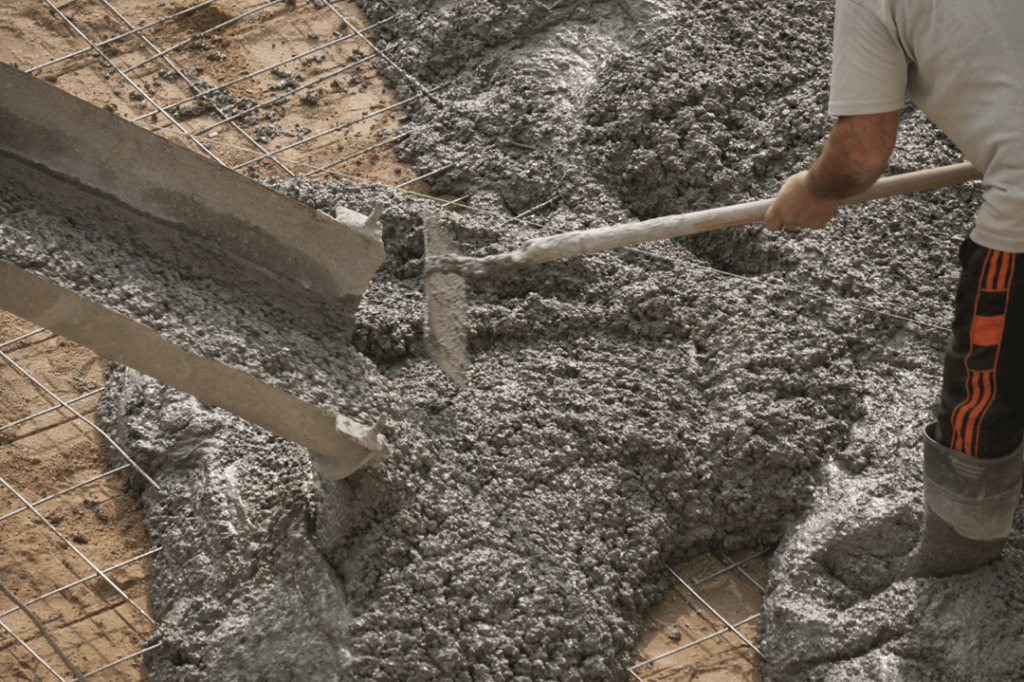Concrete is the most widely used building material in the world. It is a composite material made of several ingredients, including cement, aggregates, water, and admixtures. Concrete consists of several key components: cementitious materials, aggregates, water, and specialised admixtures. These ingredients combine to create a material that withstands weathering, fire, and environmental factors.
Knowledge of concrete composition leads to better construction decisions, problem-solving, and sustainable building practices. This information applies to both small residential projects and large-scale infrastructure development.
Cementitious Materials for Concrete
Understanding what concrete mix is made of begins with its most critical binding component: cement. As the primary adhesive agent in concrete mixtures, cement provides the essential strength and durability that makes concrete such a versatile building material.
Portland Cement
Portland cement dominates the construction industry due to its exceptional performance characteristics. Manufacturers create this fundamental ingredient by heating limestone and clay to temperatures reaching 1450°C (2640°F). This extreme heat transforms the raw materials into clinker nodules, which are then ground with gypsum into a fine, grey powder.
The resulting material creates strong bonds between aggregates when mixed with water. Engineers classify Portland cement into different strength categories (such as C10, C25, and C40) to match specific construction requirements. Each classification offers unique performance properties for different applications, from simple residential slabs to complex infrastructure projects.
Despite its structural benefits, Portland cement production generates significant carbon emissions.
Blended Cement
Blended cements reduce environmental impact while maintaining structural integrity. These formulations combine Portland cement with materials like fly ash, slag, or silica fume from industrial processes.
These blends maintain similar properties to traditional cement while reducing carbon emissions. The performance characteristics vary based on blend ratios and supplementary materials used.
Supplementary Cementitious Materials (SCMs)
SCMs, primarily industrial byproducts like fly ash, slag, and silica fume, possess pozzolanic properties that activate when exposed to calcium hydroxide during cement hydration.
SCMs enhance concrete strength and durability while reducing environmental impact by:
- Diverting industrial waste from landfills
- Reducing Portland cement requirements
- Improving performance and longevity
The resulting concrete offers improved resistance to chemical attacks, reduced permeability, and enhanced durability.
Aggregates Are The Backbone of Concrete Structure
The concrete process relies heavily on aggregates, which form 60-75% of concrete’s volume and serve as its structural skeleton. While cement provides the binding power, these inert materials contribute significantly to concrete’s strength, durability, and economic value.

Types of Aggregates in Concrete
Concrete producers select from three primary aggregate categories based on project requirements, local availability, and sustainability goals:
Natural Aggregates
Extracted directly from natural sources, these materials undergo minimal processing before use:
- River sand and gravel: Naturally rounded by water erosion
- Quarried stone: Mechanically crushed from bedrock formations
- Pit sand: Excavated from land-based deposits
Natural aggregates typically offer consistent quality and predictable performance characteristics that make them the standard choice for most construction projects.
Manufactured Aggregates
Created through industrial processes, manufactured aggregates meet specific performance requirements:
- Crushed stone: Produced by mechanical crushing of quarried rock
- Expanded shale, clay, or slate: Lightweight options created through heating
- Ground granulated slag: Byproduct of steel production
These aggregates often feature angular shapes that enhance concrete strength through improved interlocking between particles.
Recycled Aggregates
Derived from construction and demolition waste, recycled aggregates support sustainability goals:
- Crushed concrete: Processed from demolished structures
- Reclaimed brick: Repurposed masonry materials
- Reclaimed asphalt: Reprocessed pavement materials
Using recycled aggregates diverts waste from landfills and reduces demand for virgin materials, though they may require additional quality control testing.
Water Acts As The Catalyst for Concrete Strength
Water initiates hydration, the chemical reaction that transforms cement and aggregates into solid concrete. Understanding this process is essential for proper concrete formation.
The Chemistry of Hydration
When water meets cement, it dissolves calcium compounds and forms calcium silicate hydrate gel, creating bonds between aggregates. For those wondering what concrete is made of chemically, this reaction between water and cement minerals is the fundamental transformation that determines concrete’s final strength and durability.
Water Quality and Concrete Performance
Water quality directly impacts concrete quality:
- Potable water is preferred for its minimal impurities
- Non-potable sources require testing for harmful substances
- Seawater contains chlorides that may accelerate steel corrosion
The Critical Water-Cement Ratio
The water-cement ratio (w/c) significantly influences concrete performance:
- Strength: Lower ratios (0.40-0.45) produce stronger concrete
- Durability: Dense, less permeable concrete better resists damage
- Workability: Higher ratios improve flow but may reduce strength
Concrete technicians use the slump test to measure how water affects concrete consistency. Proper moisture management during mixing, placement, and curing ensures optimal concrete quality and performance.
Admixtures, The Fifth Ingredient
Most construction professionals study concrete made of recognised cement, water, and aggregates as the primary components. However, modern concrete increasingly relies on admixtures, and chemical additions that modify specific properties.
Admixtures typically constitute less than 5% of the cement weight but dramatically impact concrete performance:
- Water Reducers and Plasticizers: Allow concrete to flow more easily with less water, increasing strength and improving placement characteristics.
- Setting Time Modifiers: Accelerators speed up hardening for cold weather or urgent projects, while retarders delay setting time for hot weather or complex placements.
- Air-Entraining Agents: Introduce microscopic air bubbles that enhance freeze-thaw resistance and improve workability.
- Specialty Admixtures: Include corrosion inhibitors, shrinkage reducers, and colouring agents for specific applications.
Proper dosage and compatibility testing are essential when using multiple admixtures, as they can interact with unexpected results. Manufacturers provide recommended dosage ranges, but site-specific testing often determines the optimal amount for particular conditions and materials.
Getting Your Concrete Mix Proportions Right
Getting the perfect concrete floor process or other projects going requires precision and an understanding of how different ingredients interact. Engineers follow carefully calculated formulas to achieve specific performance characteristics.
Finding the Optimal Balance
Concrete mix proportions typically follow these general guidelines:
- Cement: 10-15% of the total volume
- Water: 15-20% of the total volume
- Aggregates: 60-75% of the total volume
- Air: 5-8% of the total volume
Organisations like the American Concrete Institute (ACI) provide standardised methods for determining mix proportions based on strength requirements, workability needs, and exposure conditions.
Final Thoughts
Choosing the right concrete ingredients is essential for producing high-quality and sustainable construction projects. Cementitious materials, aggregates, water, and admixtures all play a crucial role in the properties of concrete. Quality control measures should be in place to ensure that the concrete produced meets the required specifications and standards. Sustainable concrete ingredients, such as fly ash, slag, and recycled aggregates, can reduce the environmental impact of construction. Innovations in concrete ingredients and emerging technologies can help address the challenges facing the concrete industry.
For reliable concrete solutions, trust Pro Mix Concrete – where quality meets expertise.
Frequently Asked Questions
Concrete consists of cement, water, aggregates (sand and gravel), and often admixture
Civil engineers determine mixed designs based on project requirements and material properties.
Maintain a water-cement ratio between 0.4 and 0.6 for optimal strength and workability.
For dry mixes, carefully add small amounts of water; for wet mixes, incorporate additional dry materials.
Concrete typically reaches about 70% strength in 7 days and full strength in 28 days.
Only use tested admixtures in recommended amounts; random additions may compromise strength and durability.
- Dennis Broderick
- Dennis Broderick is the founder and owner of Pro-Mix Concrete Company, a trusted name in ready-mix concrete solutions across the UK. With over 20 years of hands-on experience in the construction and concrete industry, Dennis brings unmatched expertise, practical insights, and a commitment to quality on every project - from residential driveways to large-scale commercial developments.
 BlogDecember 10, 2025Is Ready Mix Concrete As Good As Hand Casting?
BlogDecember 10, 2025Is Ready Mix Concrete As Good As Hand Casting? BlogDecember 8, 2025How Do You Calculate The Concrete Required For A Job?
BlogDecember 8, 2025How Do You Calculate The Concrete Required For A Job? BlogNovember 26, 2025Ready Mix Concrete Costs UK: 7 Key Factors That Affect Your Price Per m³
BlogNovember 26, 2025Ready Mix Concrete Costs UK: 7 Key Factors That Affect Your Price Per m³ BlogNovember 26, 2025How Long Does Concrete Take To Cure?
BlogNovember 26, 2025How Long Does Concrete Take To Cure?





